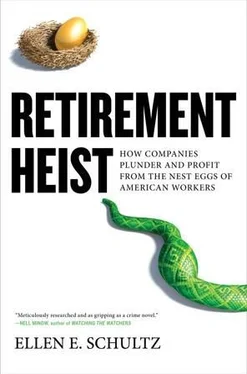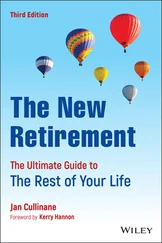IBM’s cookie jar of earnings enhancements was also running low by the end of the 1990s. IBM’s solution was to establish “health care accounts” for future retirees, which was essentially a way to further limit the amount it would pay for their health benefits. This step, which the company took in 1999, reduced the company’s liability by $127 million and generated a fresh pool of accounting gains that the company added to income over a period of years.
Benefits consultants helped their clients replenish the cookie jars. William Falk, who oversaw the retiree medical consulting practice at Towers Perrin, addressed the problem of diminishing income at an actuarial conference in the late 1990s: “So the clients are saying, ‘Well, what can we do about this? We don’t want our costs to jump up next year. Management and shareholders won’t accept it.’ Well,” he told his fellow consultants at the meeting, “they’re doing a lot of things. They’re looking at reduction in benefits again.”
Towers Perrin sent marketing materials to current and potential corporate clients, saying employers needed to think about “new strategies and approaches to managing health benefits.” Among them: tightening eligibility by requiring higher ages and years of service; getting some dependents out of the plan, such as dependent children; and increasing premiums, deductibles, and out-of-pocket expenses, “especially when you can’t get people [like union retirees] out” of the plan. Companies could also adopt “more aggressive assumptions” for health care inflation, administrative expenses, and participation rates. Health care inflation trends “have been low, but we’ve kept them high. Now we have room to move back down” and generate some new accounting gains.
Of course, companies that announce benefits cuts don’t say they’re cutting benefits because they’ve run out of accounting gains generated by earlier cuts. They generally just blame rising health care costs. That was what Aetna did in 2003 when it announced it would phase out health care benefits for workers who retired starting in 2004. The reality: Aetna’s costs were going up because it had used up the pool of gains generated when it capped the benefits in 1994. It had used as much as $23 million a year from this pool to reduce its annual expense. By 2002 those gains had run out, and to keep its expense from rising, Aetna needed to cut benefits again.
But was Aetna actually spending more money? Not really. Thanks to the ceiling on spending, the amount the company actually paid—that is, dollars out the door—remained roughly flat from 1998 through 2002, ranging between $35 million and $39 million. Asked to explain why it was cutting benefits when it wasn’t spending more, Aetna responded by saying that it needed “to reduce expenses in order to be competitive.” That answer, at least, made more sense: The maneuver increased Aetna’s pretax income by $34 million in the first quarter of 2003. That was 6.4 percent of its earnings. The gains continued to lift Aetna’s pretax earnings about $45 million a year for several more years.
Companies could time the cuts to generate gains at opportune moments. With a little preparation, companies can determine how many cents per share they need to meet earnings targets, and then identify which bits of their retiree plans to trim to generate the gains the company needs to clear the earnings hurdle. Caterpillar increased retirees’ premiums and made other benefit cuts in 2002 that reduced obligations by $475 million. This resulted in a $75 million accounting gain that year, which amounted to 9.4 percent of pretax earnings. The flexibility built into the accounting rules—and employers’ ability to trim benefits—has enabled companies to cannibalize their retiree health plans whenever they need to generate gains to boost income.
At Whirlpool, the retiree health plan has offset the cost of defective appliances over the years. In the second quarter of 2003, trims to its retiree medical benefits generated a one-time gain of $13.5 million. This added 19 cents a share—enough to offset a one-time after-tax charge of 16 cents a share to cover the cost of recalling defective microwaves, with three cents left over. This enabled the company to report earnings of $1.35 a share—beating the $1.31-a-share consensus estimates.
In March 2009, Whirlpool made another benefits trim: It suspended the annual credit it provided to the retiree health savings accounts. The $89 curtailment gain this cut generated neatly offset a one-time charge for a voluntary recall of 1.8 million refrigerators sold in the United States and Canada between 2001 and 2004. And in March and June 2010, the $62 million in gains from other cuts to the retiree health care plan largely offset the $75 million charge for recalling 1.8 million dishwashers sold in the United States and Canada between 2006 and 2010.
Chapter 5
PORTFOLIO MANAGEMENT
Swapping Populations of Retirees for Cash And Profits
ONE OF THE LAST LETTERSBill Jelly received before he died in 2003 was from his benefits administrator, informing him that the death benefit from his employer, Western Electric, was going to be canceled—in one month. He’d earned the benefit decades ago, when death benefits, like retiree health coverage, were commonly offered to people who’d spent most or all of their careers at a particular company.
The benefit wasn’t much: $39,000, the equivalent of the salary he had the year he retired in 1979. But he had been counting on it to pay his burial costs and the medical expenses the couple faced, thanks to cuts to their retiree health coverage. “I guess I’m going to have to die before then,” Jelly, who was seventy-nine, told Margaret, his wife of fifty years.
But even though Jelly had spent his entire career at Western Electric, the letter had come from Lucent Technologies, based in Murray Hill, New Jersey. At that point, Jelly had barely heard of Lucent, a spin-off created seventeen years after he had retired. But like millions of retirees across the country, his pension and retirement benefits were under new management thanks to mergers and restructurings that took place after he retired, thereby shuffling his benefits to a new company. From a management point of view, pools of retirees are essentially portfolios of debts and assets. The debts are the pensions and retiree health benefits the workers earned, and the assets are the funds set aside to pay them. When a business unit is sold, merged, acquired, or spun off, a portfolio of retirees is often packaged along with the rest of the business.
To the new owners, the retirees in the portfolio aren’t former engineers, managers, or factory workers. They’re a resource to be managed with an eye toward profits. Retirees find it unsettling that their pensions have migrated to new owners, especially when the new portfolio owners send them “Dear Retiree” letters, telling them that their health coverage is ending, their pension has been incorrectly calculated, or other benefits are being cut. When the retirees’ increasingly frantic appeals fall on deaf ears, they conclude that the new company has no loyalty to them. But they don’t realize the half of it. They’ve literally become human resources, to be consumed for cash and profits.
Chuck Ackerman discovered this with a shock in early 2000. The first sign of trouble was when his pension check didn’t arrive on time. At first he thought it was a Y2K glitch. Then he received a letter from Raytheon, a company where he had never worked, telling him that not only was he not going to get his pension check but that he actually owed the company $31,904 that he’d been mistakenly paid over the prior five years. The letter explained that the company would be withholding his pension payments for the next year and a half until the “debt” was paid off. It was like a punch in the gut for the retired pilot, who was already battling cancer.
Читать дальше












